Abstract
High concentrations of antibiotics have been identified in aqueous media, which has diminished the quality of water resources. These compounds are usually highly toxic and have low biodegradability, and there have been reports about their mutagenic or carcinogenic effects. The aim of this study was to apply zero-valent iron-oxide nanoparticles in the presence of hydrogen peroxide and the sonolysis process for the removal of the amoxicillin antibiotic from aqueous media. In this study, zero-valent iron nanoparticles were prepared by an iron chloride reduction method in the presence of sodium borohydride (NaBH4), and the obtained nanoparticles were characterized by scanning electron microscopy (SEM), transmission electron microscopy (TEM), X-ray diffraction (XRD), and vibrating-sample magnetometry (VSM). Then, using a Fenton-like process, synthetic wastewater containing 100 to 500 mg/L amoxicillin antibiotic was investigated, and the effects of different parameters, such as the frequency (1 and 2 kHz), contact time (15 to 120 min), the concentration of hydrogen peroxide (0.3%, 0.5%, and 6%), the dose of zero-valent iron nanoparticles (0.05, 0.1, 0.5 g/L), and pH (3, 5, 10) were thoroughly studied. A pH of 3, hydrogen peroxide concentration of 3%, ultrasonic-wave frequency of 130 kHz, zero-valent iron nanoparticles of 0.5 g/L, and contaminant concentration of 100 mg/L were obtained as the optimal conditions of the combined US/H2O2/nZVI process. Under the optimal conditions of the combined process of zero-valent iron nanoparticles and hydrogen peroxide in the presence of ultrasonic waves, a 99.7% removal efficiency of amoxicillin was achieved in 120 min. The results show that the combined US/H2O2/nZVI process could be successfully used to remove environmental contaminants, including antibiotics such as amoxicillin, with a high removal percentage.
1. Introduction
Drugs and related products have been considered a major concern in recent years and have drawn a lot of attention. Drugs treat or prevent microbial infections in humans and even animals. Pharmaceutical compounds such as antibiotics are detected in aqueous environments. These compounds are present in surface water, groundwater, wastewater, and even drinking water. Pharmaceutical compounds can be released into the environment in a variety of ways, such as through the pharmaceutical industry, hospital effluents, and human and animal feces. Typically, 3000 types of drugs are used in the UK [1], and the annual drug production for human consumption is more than 100 for each country in the EU [2]. Antibiotics are one of the most extensively used drugs in Europe, which is estimated to be nearly 100,000 tonnes annually [3].
Low biological biodegradability [4], high toxicity [5], and a mutagenic and carcinogenic nature are the main properties of antibiotics [6]. Moreover, according to the increasing amounts of these compounds in wastewater, antibiotics will be a critical challenge in the future.
The β-lactam group accounts for 65% of global antibiotics, among which the amoxicillin group is the most widely used [7]. In Iran, 32.6% of antibiotics belong to the β-lactam group (ampicillin, amoxicillin, and penicillin), in which amoxicillin is the most widely used. Amoxicillin is a semi-synthetic penicillin containing a beta-lactam ring with a molecular weight of 365.4 g/mol, which inhibits bacterial cell wall synthesis [8,9], and effectively treats systemic and gastrointestinal infections [10]. According to the reported literature, the concentrations of these antibiotics in surface waters were 48 mg/L, and the amoxicillin concentration in hospital wastewater was in the range of 28 to 7.7 mg/L [11]. However, there may be high concentrations of this antibiotic in industrial wastewater. Mousavi et al. and Zhao et al. reported the removal of 2–5 mg/L amoxicillin from water and wastewater [12,13]. Studies have revealed that most antibiotics are non-biodegradable and depart from the wastewater treatment plant unchanged. Therefore, developing an effective treatment method is desired. Combining zero-valent iron nanoparticles with hydrogen peroxide and ultrasonic waves can be an effective method for antibiotic removal. Combining zero-valent iron nanoparticles with hydrogen peroxide and ultrasonic waves and the generation of high-energy hydroxyl radicals can play an effective role in contaminant and antibiotic removal [14]. This process is based on the generation of free hydroxide radicals, which convert diverse kinds of organic chemical compounds to minerals due to their high oxidation power [15,16].
Zhou et al. used a combination of iron nanoparticles and the hydrogen peroxide process to remove 4-chlorophenol [17]. Vahidi et al. also utilized the combined US/H2O2/nZVI process to remove 2,4-dichlorophenoxyacetic acid [18].
Recently, a study was conducted on the activation of hydrogen peroxide with a pseudo-catalyst using powdered iron [19]. In this study, the removal of the amoxicillin antibiotic by the HS/Fe/H2O2 combination process was investigated. Ultrasonic waves increase the oxidation and production of ferrous ions, which have more hollow spaces than zero-valent iron (Reaction 1). The generated ferrous ions react with hydrogen peroxide in the reaction medium and activate the production of hydroxyl radicals, which in turn oxidize the organic compounds (Reactions 1–2). This reaction is the so-called Fenton system. However, these reactions have some limitations, among which is the generation of intermediate products such as Fe(OOH)2+ (Reaction 5) and Fe(OH)2+ (Reaction 7). Ultrasonic waves, unlike iron, induce the generation of the hydroperoxy radical (•OOH) (Reaction 6) and hydroxyl radical (•OH) (Reaction 8) [20,21]. Therefore, active species can participate in redox reactions (Reactions 3, 4, and 9).
Fe0 + 2H+ + Ultrasonic → Fe2+ + H2 (in acid solution)
H2O2 + Fe2+ → ●OH + OH−
Fe2+ + ●OH→ Fe3+ + OH−
OH + RH → R◦ + H2
Fe3+ + H2O2 → Fe….OOH2+ + H+
Ultrasonic → ●O2H + Fe2+ Fe….OOH2+
Fe3+ + H2O → [Fe (OH)2+] + H+
[Fe (OH)2+] + Ultrasonic → Fe2+ + ●O
Fe3+ + ●O2H → Fe2++ H+ + O2
Under optimum conditions, the generated ferric ions (Reaction 2) can react with the excess hydrogen peroxide (Reaction 5) or water (Reaction 7). Ferric ions also react with oxidase (Reaction 10) or metallic iron (Reaction 11) when they are converted to ferrous species, and this cycle continues.
R● + Fe3+ → R+ + Fe2+
→ 3 Fe2+ Fe + 2 Fe3+
The above point clearly indicates that Fenton reactions are limited to the presence of iron cations in the intermediate reaction, as well as the ability of the intermediate reaction to regenerate and continuously produce the solute iron species. Research has shown that ultrasonic waves play a critical role in the dissolution of iron particles in a medium; therefore, the addition of zero-valent iron (for the generation of ferrous and ferric ions) and hydrogen peroxide (for the production of hydroxyl radical ions) and ultrasonic irradiation induce complex redox reactions, which in turn cause the degradation of the antibiotic [22].
AMX + ●OH/●O2H/other active radicals → (oxidized AMX) → Harmless species
(XH2O2, intermediates Yco2, etc.)
In light of the issue of amoxicillin in hospital effluents and water resources and, ultimately, its effects on human health, the goal of the current study was to synthesize zero-valent iron nanoparticles, determine their characteristics, and combine them with hydrogen peroxide along with ultrasonic waves to investigate amoxicillin removal from aqueous solutions.
2. Materials and Methods
2.1. Chemicals and Reagents
The amoxicillin antibiotic and methanol were obtained from Sigma Aldrich (Burghausen, Germany), and hydrochloric acid was obtained from Scharlau Chemie (Barcelona, Spain). Hydrogen peroxide 30%, sulfuric acid 98%, sodium hydroxide, potassium iodide, sodium thiosulfate, and starch were purchased from CMC (Frankfurt, Germany). Whatman filters with a pore size of 1.5 microns were obtained from Prolabo (Paris, France) to filter the samples.
2.2. Synthesis of Zero-Valent Iron Nanoparticles
Zero-valent iron nanoparticles were synthesized according to Ibrahem et al.’s method as follows [23]: Iron nanoparticles were synthesized by mixing a ferric chloride (FeCl3) solution with a solution containing a reducing agent. The ferric chloride solution was prepared by dissolving 0.4 g of ferric chloride in 50 mL of deionized water. Then, in order to prepare the reducing agent solution, 0.6 g of sodium borohydride (NaBH4) was dissolved in 100 mL of deionized water. This solution (containing a reducing agent) was immersed in an ice bath before the ferric chloride solution was added dropwise with a flow rate of 0.13 mL/s using a microtube pump (Figure 1). It is worth mentioning that when no bubbles are produced for a long time, the reaction is considered complete. The final product was a black sludge, which was separated by a strong magnet. Then, the zero-valent iron nanoparticles were washed several times with distilled water and acetone to remove the residues and impurities. Finally, the synthesized nanoparticles were stored in a desiccator under nitrogen gas (oxygen-free conditions to prevent oxidation).
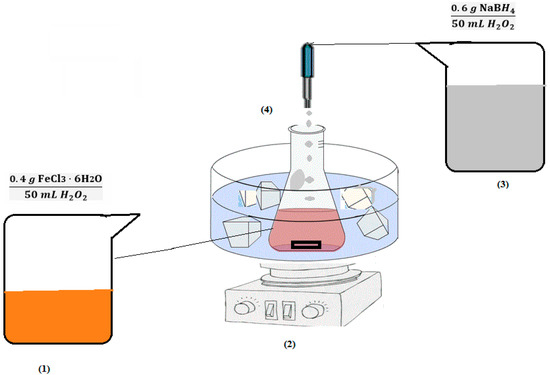
Figure 1.
The scheme of the synthesis of zero-valent iron nanoparticles.
2.3. Characterization of Zero-Valent Iron Nanoparticles
The characteristics, morphology, and size of nZVI were analyzed using a scanning electron microscope (SEM; model KyKy-EM3200) and transmission electron microscope (TEM; model PHILIPS, EM, 100 Kv). The crystal structure of the nanoparticles was also determined by X-ray diffraction (XRD) using an XRD 3100 diffractometer (Eindhoven, Netherlands, Philips model). Moreover, the magnetic properties of the nanoparticles were determined using a 7410 Shore Lake vibrating-sample magnetometer.
3. Experimental Section
In this study, specific doses of zero-valent iron nanoparticles (0.05, 0.1, and 0.5 g/L), different initial concentrations of AMX (100, 300, and 600 mg/L), and certain concentrations of hydrogen peroxide (0.3%, 1%, and 2%) were added to the reactor. The reaction times were varied (15, 30, 60, 90, and 120 min), and pH was set to three values (3, 5, and 11) [24]. To produce ultrasonic waves, an ultrasonic bath was used, which was capable of generating ultrasonic waves at frequencies of 35 and 130 kHz with a power of 500 W Elma Schmidbauer GmbH, Singen, Germany). Samples containing zero-valent iron nanoparticles were passed through a 0.2 μm filter at the end of the reaction. To attain the calibration curve, solutions with specific concentrations of amoxicillin were injected into the Shimadzu HPLC apparatus (Kyoto, Japan) to be detected, and by calculating the peak area of the resulting peaks, the calibration curve was plotted to determine the unknown concentrations. After determining the residual concentration of amoxicillin in the samples, the removal efficiency of the different conditions, as well as the optimum reaction conditions, were determined. In order to determine the hydrogen peroxide in the output samples and to assay the hydrogen peroxide used in the research, the potassium iodide method was used [25].
Removal of the interference of hydrogen peroxide in the COD assay:
Hydrogen peroxide interferes in the COD test as follows [26].
Cr2O7−2 + 3H2O2 + 8H+→ 2Cr 3+ + 7H2O
H2Cr2O7 + 5H2O2 → H2Cr2O12 + 5 H2O
H2Cr2O12 + 8H2O2 → Cr2O3 + 9H2O + 8O2
Although hydrogen peroxide is volatile on its own, its volatility can be reduced in synthetic samples by adding some substances. Consequently, the best way to eliminate the interference of hydrogen peroxide is to measure its residual concentration in the output samples and correct the COD. However, measurements of hydrogen peroxide in the output samples revealed that the residual amount of hydrogen peroxide was not significant. To remove hydrogen peroxide from the environment, different kinds of methods, including the usage of sodium thiosulfate or sodium borohydride, boiling, and incubation in a water bath at a temperature of 45 °C for 24 h, were considered [27].
Analysis of Samples
After the preparation of input and output samples of the reactor (centrifugation and passage through a 0.2 μm filter), the samples were injected into the HPLC device to determine the removal efficiency of amoxicillin. The amoxicillin antibiotic concentration was determined by HPLC (HPLC, Shimadzu, Kyoto, Japan, LC 10 A HPLC) equipped with a UV detector (SPD-10 AV) at 420 nm using a mobile phase with a volume percentage of 95:5 of potassium dihydrogen phosphate and methanol. The peak corresponding to the standard graph obtained from the HPLC device is shown in Figure 2. Equation (16) shows the removal efficiency of AMX:
where Ci and Co are the initial and residual concentrations of AMX (mg/L).
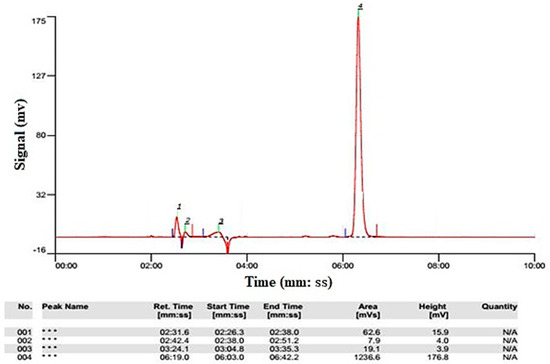
Figure 2.
The graph obtained from the HPLC instrument.
The measurement of the final concentration of the amoxicillin antibiotic was the main criterion for evaluating the process. Test number 5220B in the book of standard methods was used to measure the COD parameter in the input and output samples of the reactor in order to detect the conversion rate and the removal efficiency of the amoxicillin contaminant. All experiments were performed according to the instructions of the Standard Methods for the Examination of Water and Wastewater book [28]. The experiments were repeated three times, and the average results are reported.
4. Results
4.1. Properties of the Synthesized Nanoparticles
Figure 3a–d show the TEM, XRD, VSM, and SEM analysis results of the synthesized nanoparticles. The XRD patterns were drawn for angles of 30–90. According to Figure 3a, peaks 42 and 66 indicate the formation of nZVI nanoparticles, which is in accordance with the study by Dong et al. [29]. The VSM analysis was used to study the magnetic behavior of nZVI, which was measured at 65 emu/g, and TEM images revealed that spherical nanoparticles were in a chain-like form with a rough surface. Moreover, the sizes of nanoparticles were 25–50 nm, according to SEM.
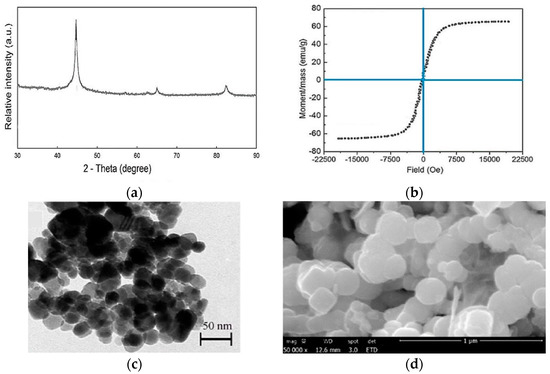
Figure 3.
(a) XRD; (b) VSM; (c) TEM; (d) SEM analyses of the synthesized nanoparticles.
4.2. Investigation of the Effect of Different Dosages of Iron Nanoparticles
In this study, to evaluate the effect of the zero-valent iron nanoparticle dosage, values of 0.05, 0.1, and 0.5 g/L were selected. The obtained results are presented in Figure 4. Under these conditions, the amoxicillin concentration, hydrogen peroxide concentration, frequency, and pH considered were 100 mg/L, 1%, 130 kHz, and 5, respectively. The results showed that the removal efficiency increased with the increasing dosage of nanoparticles, so the highest efficiency was observed at a dosage of 0.5 g/L.
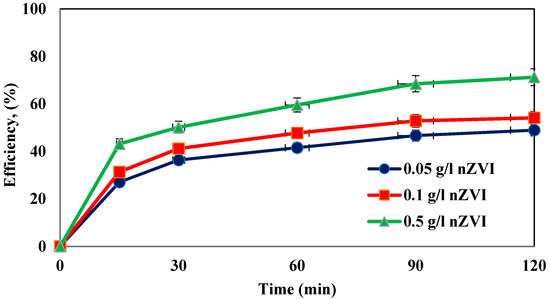
Figure 4.
Effect of different dosages of zero-valent iron nanoparticles on the removal efficiency of amoxicillin antibiotic (under conditions of AMX = 100 ppm, pH = 5, H2O2 = 1%, and frequency 130 kHz).
4.3. Determination of the Optimum Concentration of Hydrogen Peroxide
Hydrogen peroxide is a parameter that influences the Fenton process. In this study, the effect of hydrogen peroxide on the oxidation of the amoxicillin antibiotic was investigated. In order to achieve the best process efficiency, the contaminant was exposed to different concentrations of hydrogen peroxide (0.05, 1%, and 3%). As shown in Figure 5, the maximum removal efficiency of 95% was obtained at a concentration of 3% and after 120 min.
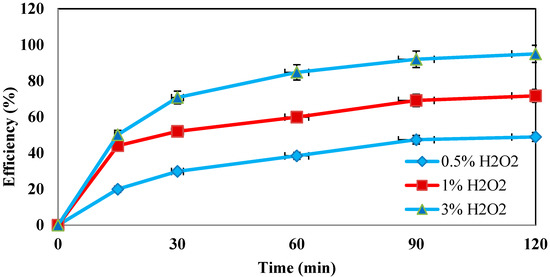
Figure 5.
Effect of different concentrations of hydrogen peroxide on the removal efficiency of amoxicillin antibiotic (under conditions of AMX = 100 ppm, pH = 5, nZVI = 0.5 g/L, and frequency 130 kHz).
4.4. Determination of the Effect of pH Changes
The effect of initial pH values of 3, 5, and 11 was investigated in the presence of 100 mg/L amoxicillin, 3% hydrogen peroxide, ultrasonic waves of 130 kHz, and 0.5 g/L iron nanoparticles. As shown in Figure 6, the efficiency of the nano-Fenton process decreased as the pH increased, so the maximum removal efficiency was observed at pH = 3.
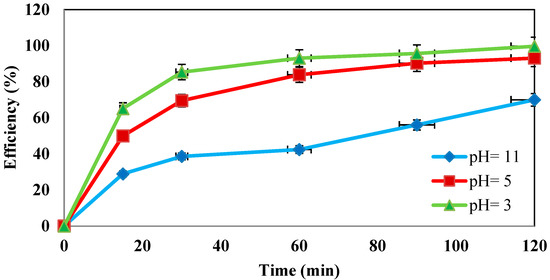
Figure 6.
Effect of pH on the removal efficiency of amoxicillin antibiotic (under conditions of AMX = 100 ppm, H2O2 = 3%, nZVI = 0.5 g/L, and frequency 130 kHz).
4.5. Determination of the Effect of Frequency Changes on the System’s Efficiency
Figure 7 shows the removal efficiency of the amoxicillin antibiotic at two ultrasonic frequencies (35 and 130 kHz) in the presence of 100 mg/L amoxicillin, 3% hydrogen peroxide, and 0.5 g/L iron nanoparticles. The reaction time in these conditions was 0–120 min, and the results indicated that the process showed more efficiency at the 130 kHz frequency.
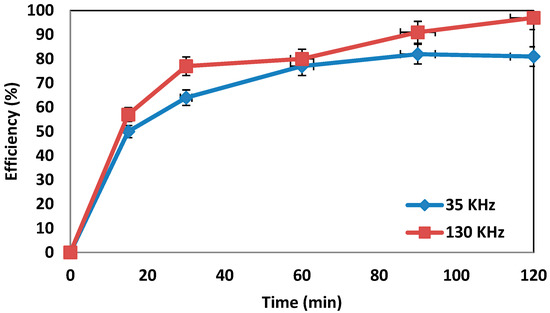
Figure 7.
Effect of frequency on the removal efficiency of amoxicillin antibiotic (under conditions of AMX = 100 ppm, pH = 3, nZVI = 0.5 g/L, and H2O2 = 3%).
4.6. Effect of Different Concentrations of Amoxicillin Antibiotic
The effect of different concentrations of amoxicillin was also studied in the presence of nZVI = 0.5 g/L, H2O2 = 3%, pH = 3, and frequency = 130 kHz. The obtained results are shown in Figure 8.
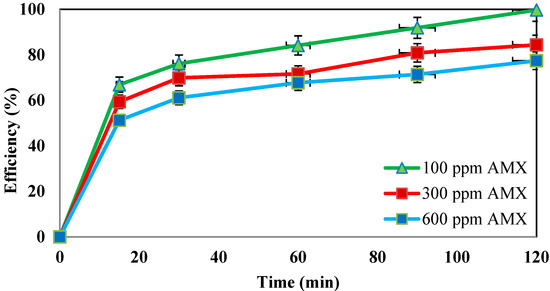
Figure 8.
Effect of initial concentration of amoxicillin antibiotic on the system performance (under conditions of nZVI = 0.5 g/L, H2O2 = 3%, pH = 3, and frequency of 130 kHz).
4.7. Determination of the Efficiency of the Process in the Absence of One of the Parameters
In this study, the efficiency of the US/H2O2/nZVI process was investigated. In order to study the effect of the combination of these processes on amoxicillin removal, the efficacy of each of these parameters was examined individually, and the results were compared with those of the combined process. The results are presented in Figure 9. As can be seen in all of the figures, these experiments were performed using US, nZVI, and H2O2 individually and the combination of each of them, and the results were compared with those of the combined method.
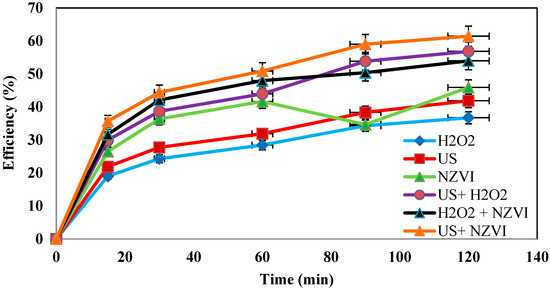
Figure 9.
Effect of removal parameters in the absence of one or two factors (under conditions of AMX = 100 ppm, nZVI = 0.5 g/L, H2O2 = 3%, pH = 3, and frequency of 130 kHz).
4.8. Determination of the System Performance in COD Removal
The efficiency of the nano-Fenton process in removing the COD of the amoxicillin antibiotic was also investigated. To measure the COD, the reflex method was used according to Experiment No. 5220B of the Standard Methods Book [28]. The obtained results are presented in Figure 10.

Figure 10.
The system’s efficiency in COD removal (under conditions of AMX = 100 ppm, nZVI = 0.5 g/L, H2O2 = 3%, pH = 3, and frequency of 130 kHz).
5. Discussion
Investigation of the effect of different dosages of iron nanoparticles. The highest removal of AMX obtained was 72% using 0.5 g/L zero-valent iron nanoparticles. The increase in the adsorbent surface or its availability to antibiotic molecules, which was obtained by increasing the adsorbent dose, increases the removal percentage [30]. In Ali et al.’s study, the application of a green approach using pomegranate peel coated with zero-valent iron nanoparticles was used for the removal of amoxicillin. They reported that the removal efficiency increased with an increase in the adsorbent dosage (0.25–2.5 g/L) [31].The same results were obtained by Antoine Ghauch et al. for carbamazepine removal using the combined ultrasonic/Fe/H2O2 process [13]. Zhang et al. also found that the system’s efficiency increased with the increase in zero-valent iron nanoparticles [16].
Determination of the optimum dose of hydrogen peroxide. In order to achieve the best performance in amoxicillin removal, the contaminant was exposed to different doses of hydrogen peroxide (0.5%, 1%, and 3%). According to the results, the highest removal of 95% was achieved at a concentration of 3% and with the maximum time. Studies have shown that if excess hydrogen peroxide remains in the medium, the hydrogen peroxide itself reacts with the hydroxyl radicals, which in turn reduces the removal efficiency of the system [32]. Due to the improved efficiency of the system at 3% hydrogen peroxide, it can be confirmed that no excess hydrogen peroxide was present in the medium. The findings of Antoine Ghauch et al. also showed that increasing hydrogen peroxide to optimal concentrations would improve the system’s efficiency [13].
Determination of the effect of pH changes. According to the diagrams and curves shown, the amount of contaminant removal increased dramatically at pH = 3 to 99.7%. However, the amount of contaminant removal decreased significantly at pH = 11. These results indicate that pH plays a critical role in system performance. The higher removal efficiency under acidic conditions for amoxicillin can be attributed to the generation of more OH radicals, which can rapidly oxidize the reactive AMX molecule [33]. Zero-valent iron nanoparticles have better solubility in acidic environments compared to alkaline conditions. Under alkaline conditions, zero-valent iron nanoparticles aggregate and agglomerate, which significantly reduces the efficiency of the system as well as the contact between the particles and hydrogen peroxide. Advanced oxidation processes perform better in acidic environments than in alkaline environments [34]. Studies by Catalkaya and Sengul also confirm these results [35].
Determination of the effect of frequency changes on system performance. The system performance was examined at a frequency of 5 kHz, and the results showed that the removal rate of the system was 90% at a frequency of 35 kHz. The findings demonstrate that changing the frequency from 130 kHz to 35 kHz at constant power has no significant effect on system performance; however, in this case, the efficiency of the system was reduced. The obtained results are consistent with the findings of Manousaki et al. [36].
Determination of the efficiency of the system at different concentrations of amoxicillin antibiotic. The results of evaluating the efficiency of the nano-Fenton process at different concentrations of amoxicillin showed that the removal rate was equal to 77.4%, 84.4%, and 99.7% at concentrations of 600 ppm, 300 ppm, and 100 ppm, respectively (Diagram 7). Since the production of hydroxyl radicals will remain constant under constant conditions, they will be consumed by increasing the amount of the contaminant in the radical environment. Therefore, the efficiency of the process will decrease with increasing concentrations of contaminants [37]. The results of Seid-Mohammadi’s study showed that the removal efficiency in the combined US/H2O2/NiO process decreases with the increase in the concentration of antibiotics [38]. Hung-Yee Shu et al. found that the process efficiency decreases with increasing contaminant concentration [39].
Determination of the efficiency of the process in the absence of one of the parameters. In order to evaluate the effect of each factor used in the combined system, under optimum conditions, 100 mg/L of the contaminant was put into contact with ultrasonic waves alone, zero-valent iron nanoparticles alone, hydrogen peroxide alone, and the combination of two parameters in the absence of one of the parameters. The results showed that in the absence of ultrasonic waves, hydrogen peroxide, or zero-valent iron nanoparticles, even under acidic conditions, the system performance was significantly reduced. This difference in the system performance can be clearly observed by comparing the diagrams of US/H2O2/nZVI and H2O2/nZVI, which shows the critical role of ultrasonic waves in improving the efficiency of the system. Ultrasonic waves enable better mixing of zero-valent iron nanoparticles and more contact with hydrogen peroxide. In addition, ultrasonic waves increase the contact surface of zero-valent iron nanoparticles with hydrogen peroxide by creating tiny bubbles (cavitation). On the other hand, the absence of hydrogen peroxide in the medium results in the removal of hydroxyl radical sources (although ultrasonic waves are somewhat capable of generating hydroxyl radicals from water molecules, the amount of the produced hydroxyl radical is not enough). The absence of zero-valent iron nanoparticles, which are considered a major source of electrons, which are donated to hydrogen peroxide and produce hydroxide radicals, can cause the disruption and diminished removal efficiency of the amoxicillin antibiotic. The obtained results confirm the necessity of the presence of each of these parameters in the process (ultrasonic waves, hydrogen peroxide, and zero-valent iron nanoparticles).
Determination of the system performance in COD removal. The COD test was performed to evaluate the efficiency of the system in converting the amoxicillin antibiotic to water and carbon dioxide, which was investigated in this study. The COD measurement was performed using the open reflex method according to Experiment No. B5220 of the Standard Methods Book [28]. As shown in the relevant diagram, the system’s efficiency in removing COD in the presence of the three parameters used in the system is significantly increased. The findings also illustrate that the system used in this study is not capable of the complete removal of COD from the solution, which indicates that the contaminant may be converted to other substances, and therefore, further investigation is needed. Similar results were obtained in the study by Emad S. Elmolla et al. on COD removal [40].
6. Conclusions
The aim of this study was to investigate the application of zero-valent iron oxide nanoparticles in the presence of hydrogen peroxide and the sonolysis process in the removal of the amoxicillin antibiotic from aqueous media. Zero-valent iron nanoparticles were successfully synthesized using the reduction method, and the results showed that the maximum system efficiency occurred at lower contaminant concentrations, under acidic conditions, in the presence of 0.5 g/L zero-valent iron nanoparticles and 3% hydrogen peroxide, and with maximum contact time. The results also indicate that the pH of the medium has a significant effect on increasing the system’s efficiency in the removal of the amoxicillin antibiotic. The presence of ultrasonic waves also has a significant effect on the system’s efficiency, so according to all of the results of this study, the combined US/H2O2/nZVI process can be considered a promising candidate for the removal of the antibiotic.
Author Contributions
Methodology, L.M., H.K., A.A., A.M., M.G., A.R. and G.Z.K.; investigation, L.M., H.K., A.A., A.M., M.G., A.R. and G.Z.K.; writing—original draft preparation, L.M., H.K., A.A., A.M., M.G., A.R. and G.Z.K.; writing—review and editing, L.M., H.K., A.A., A.M., M.G., A.R. and G.Z.K.; supervision, A.R. and G.Z.K. All authors have read and agreed to the published version. All authors have read and agreed to the published version of the manuscript.
Funding
This work was supported by the Research Grant of Zahedan University of Medical Sciences, Iran (Grant No. IR.ZAUMS.REC.1399.046).
Institutional Review Board Statement
Not applicable.
Informed Consent Statement
Not applicable.
Data Availability Statement
The data presented in this research are available on request from the corresponding author.
Conflicts of Interest
The authors declare no conflict of interest.
References
- Hao, C.; Zhao, X.; Yang, P. GC-MS and HPLC-MS Analysis of Bioactive Pharmaceuticals and Personal-Care Products in Environmental Matrices. TrAC Trends Anal. Chem. 2007, 26, 569–580. [Google Scholar] [CrossRef]
- Zhang, Y.; Geißen, S.-U.; Gal, C. Carbamazepine and Diclofenac: Removal in Wastewater Treatment Plants and Occurrence in Water Bodies. Chemosphere 2008, 73, 1151–1161. [Google Scholar] [CrossRef]
- Ternes, T.A. Occurrence of Drugs in German Sewage Treatment Plants and Rivers. Water Res. 1998, 32, 3245–3260. [Google Scholar] [CrossRef]
- Tixier, C.; Singer, H.P.; Oellers, S.; Müller, S.R. Occurrence and Fate of Carbamazepine, Clofibric Acid, Diclofenac, Ibuprofen, Ketoprofen, and Naproxen in Surface Waters. Environ. Sci. Technol. 2003, 37, 1061–1068. [Google Scholar] [CrossRef] [PubMed]
- Hai, F.I.; Yang, S.; Asif, M.B.; Sencadas, V.; Shawkat, S.; Sanderson-Smith, M.; Gorman, J.; Xu, Z.-Q.; Yamamoto, K. Carbamazepine as a Possible Anthropogenic Marker in Water: Occurrences, Toxicological Effects, Regulations and Removal by Wastewater Treatment Technologies. Water 2018, 10, 107. [Google Scholar] [CrossRef]
- Miao, X.-S.; Metcalfe, C.D. Determination of Carbamazepine and Its Metabolites in Aqueous Samples Using Liquid Chromatography−Electrospray Tandem Mass Spectrometry. Anal. Chem. 2003, 75, 3731–3738. [Google Scholar] [CrossRef] [PubMed]
- Ashtarinezhad, A.; Panahyab, A.; Mohamadzadehasl, B.; Shirazi, F.H. Characterization of Miconazole effects on Mice fetus liver tissue using FTIR-MSP. Iran. J. Pharm. Res. IJPR 2017, 16, 677–684. [Google Scholar] [CrossRef] [PubMed]
- Aksu, Z.; Tunç, Ö. Application of Biosorption for Penicillin G Removal: Comparison with Activated Carbon. Process Biochem. 2005, 40, 831–847. [Google Scholar] [CrossRef]
- Rivera-Utrilla, J.; Sánchez-Polo, M.; Prados-Joya, G.; Ferro-García, M.; Bautista-Toledo, I. Removal of Tinidazole from Waters by Using Ozone and Activated Carbon in Dynamic Regime. J. Hazard. Mater. 2010, 174, 880–886. [Google Scholar] [CrossRef] [PubMed]
- Kümmerer, K.; Al-Ahmad, A.; Mersch-Sundermann, V. Biodegradability of Some Antibiotics, Elimination of the Genotoxicity and Affection of Wastewater Bacteria in A Simple Test. Chemosphere 2000, 40, 701–710. [Google Scholar] [CrossRef]
- Githinji, L.J.M.; Musey, M.K.; Ankumah, R.O. Evaluation of the Fate of Ciprofloxacin and Amoxicillin in Domestic Wastewater. Water Air Soil Pollut. 2010, 219, 191–201. [Google Scholar] [CrossRef]
- Xing Zha, S.; Zhou, Y.; Jin, X.; Chen, Z. The Removal of Amoxicillin from Wastewater Using Organobentonite. J. Environ. Manag. 2013, 129, 569–576. [Google Scholar] [CrossRef]
- Ghauch, A.; Baydoun, H.; Dermesropian, P. Degradation of Aqueous Carbamazepine in Ultrasonic/Fe0/H2O2 Systems. Chem. Eng. J. 2011, 172, 18–27. [Google Scholar] [CrossRef]
- Ghafoori, S.; Mowla, A.; Jahani, R.; Mehrvar, M.; Chan, P.K. Sonophotolytic Degradation of Synthetic Pharmaceutical Wastewater: Statistical Experimental Design and Modeling. J. Environ. Manag. 2015, 150, 128–137. [Google Scholar] [CrossRef] [PubMed]
- Shirazi, E.; Torabian, A.; Nabi-Bidhendi, G. Research Article Carbamazepine Removal from Groundwater: Effectiveness of the Tio2/UV, Nanoparticulate Zero-Valent Iron, and Fenton (NZVI/H2O2) Processes. CLEAN–Soil Air Water 2013, 41, 1062–1072. [Google Scholar] [CrossRef]
- Zhang, W.; Gao, H.; He, J.; Yang, P.; Wang, D.; Ma, T.; Xia, H.; Xu, X. Removal of Norfloxacin Using Coupled Synthesized Nanoscale Zero-Valent Iron (Nzvi) With H2O2 System: Optimization of Operating Conditions and Degradation Pathway. Sep. Purif. Technol. 2016, 172, 158–167. [Google Scholar] [CrossRef]
- Zhou, Y.; Zhang, Y.; Hu, X. Novel Zero-Valent Co–Fe Encapsulated in Nitrogen-Doped Porous Carbon Nanocomposites Derived from Cofe2o4@ZIF-67 For Boosting 4-Chlorophenol Removal Via Coupling Peroxymonosulfate. J. Colloid Interface Sci. 2020, 575, 206–219. [Google Scholar] [CrossRef]
- Vahidi, H.; Rahmani, S. Amoxicillin Removal from Aqueous Solutions Using US/H2O2/NZVI process. J. Environ. Health Eng. 2018, 5, 184–196. [Google Scholar] [CrossRef][Green Version]
- Fazlzadeh, M.; Rahmani, A.; Nasehinia, H.R.; Rahmani, H.; Rahmani, K. Degradation of Sulfathiazole Antibiotics in Aqueous Solutions by Using Zero Valent Iron Nanoparticles and Hydrogen Peroxide. Koomesh 2016, 18, 350–356. [Google Scholar]
- Valentine, R.L.; Wang, H.C.A. Iron Oxide Surface Catalyzed Oxidation of Quinoline by Hydrogen Peroxide. J. Environ. Eng. 1998, 124, 31–38. [Google Scholar] [CrossRef]
- Gholami, M.; Rahmani, K.; Rahmani, A.; Rahmani, H.; Esrafili, A. Oxidative Degradation of Clindamycin in Aqueous Solution Using Nanoscale Zero-Valent Iron/H2O2/US. Desalination Water Treat. 2016, 57, 13878–13886. [Google Scholar] [CrossRef]
- Molina, R.; Martínez, F.; Melero, J.A.; Bremner, D.H.; Chakinala, A.G. Mineralization of Phenol by a Heterogeneous Ultrasound/Fe-SBA-15/H2O2 Process: Multivariate Study by Factorial Design of Experiments. Appl. Catal. B Environ. 2006, 66, 198–207. [Google Scholar] [CrossRef]
- Ibrahem, A.K.; Moghny, T.A.; Mustafa, Y.M.; Maysour, N.E.; Dars, F.M.S.E.D.E.; Hassan, R.F. Degradation of Trichloroethylene Contaminated Soil by Zero-Valent Iron Nanoparticles. ISRN Soil Sci. 2012, 2012, 1–9. [Google Scholar] [CrossRef]
- Fang, Z.; Chen, J.; Qiu, X.; Qiu, X.; Cheng, W.; Zhu, L. Effective Removal of Antibiotic Metronidazole from Water by Nanoscale Zero-Valent Iron Particles. Desalination 2011, 268, 60–67. [Google Scholar] [CrossRef]
- Reichert, J.S.; McNeight, S.A.; Rudel, H.W. Determination of Hydrogen Peroxide and Some Related Peroxygen Compounds. Ind. Eng. Chem. Anal. Ed. 1939, 11, 194–197. [Google Scholar] [CrossRef]
- Talinli, I.; Anderson, G. Interference of Hydrogen Peroxide on the Standard Cod Test. Water Res. 1992, 26, 107–110. [Google Scholar] [CrossRef]
- Wu, T.; Englehardt, J.D. A New Method for Removal of Hydrogen Peroxide Interference in the Analysis of Chemical Oxygen Demand. Environ. Sci. Technol. 2012, 46, 2291–2298. [Google Scholar] [CrossRef]
- Carranzo, I.V. Standard Methods for Examination of Water and Wastewater. In Anales De Hidrología Médica; Universidad Complutense de Madrid: Madrid, Spain, 2012; Volume 5, p. 185. [Google Scholar]
- Dong, H.; Zhao, F.; He, Q.; Xie, Y.; Zeng, Y.; Zhang, L.; Tang, L.; Zeng, G. Physicochemical Transformation of Carboxymethyl Cellulose-Coated Zero-Valent Iron Nanoparticles (Nzvi) In Simulated Groundwater Under Anaerobic Conditions. Sep. Purif. Technol. 2016, 175, 376–383. [Google Scholar] [CrossRef]
- Weng, X.; Cai, W.; Lin, S.; Chen, Z. Degradation Mechanism of Amoxicillin Using Clay Supported Nanoscale Zero-Valent Iron. Appl. Clay Sci. 2017, 147, 137–142. [Google Scholar] [CrossRef]
- Ali, I.; Afshinb, S.; Poureshgh, Y.; Azari, A.; Rashtbari, Y.; Feizizadeh, A.; Hamzezade, A.; Fazlzadeh, M. Green Preparation of Activated Carbon from Pomegranate Peel Coated with Zero-Valent Iron Nanoparticles (Nzvi) And Isotherm and Kinetic Studies of Amoxicillin Removal in Water. Environ. Sci. Pollut. Res. 2020, 27, 36732–36743. [Google Scholar] [CrossRef]
- Pirsaheb, M.; Moradi, S.; Shahlaei, M.; Wang, X.; Farhadian, N. A New Composite of Nano Zero-Valent Iron Encapsulated in Carbon Dots for Oxidative Removal of Bio-Refractory Antibiotics from Water. J. Clean. Prod. 2018, 209, 1523–1532. [Google Scholar] [CrossRef]
- Alvani, V.; Nabizadeh, R.; Ansarizadeh, M.; Mahvi, A.H.; Rahmani, H. Predicting TOC Removal Efficiency in Hybrid Biological Aerated Filter Using Artificial Neural Network. Desalination Water Treat. 2015, 57, 20283–20291. [Google Scholar] [CrossRef]
- Zare, M.R.; Amin, M.; Nikaeen, M.; Bina, B.; Rahmani, A.; Borji, S.H.; Rahmani, H. Acute Toxicity of Hg, Cd, and Pb Towards Dominant Bacterial Strains of Sequencing Batch Reactor (SBR). Environ. Monit. Assess. 2015, 187, 1–8. [Google Scholar] [CrossRef] [PubMed]
- Çatalkaya, E.Ç.; Şengül, F. Application of Box–Wilson Experimental Design Method for the Photodegradation of Bakery’s Yeast Industry with UV/H2O2 and UV/H2O2/Fe (II) Process. J. Hazard. Mater. 2006, 128, 201–207. [Google Scholar] [CrossRef]
- Manousaki, E.; Psillakis, E.; Kalogerakis, N.; Mantzavinos, D. Degradation of Sodium Dodecylbenzene Sulfonate in Water by Ultrasonic Irradiation. Water Res. 2004, 38, 3751–3759. [Google Scholar] [CrossRef] [PubMed]
- Kavitha, V.; Palanivelu, K. The Role of Ferrous Ion in Fenton and Photo-Fenton Processes for the Degradation of Phenol. Chemosphere 2004, 55, 1235–1243. [Google Scholar] [CrossRef] [PubMed]
- Seid-Mohammadi, A.; Asgarai, G.; Ghorbanian, Z.; Dargahi, A. The removal of cephalexin antibiotic in aqueous solutions by ultrasonic waves/hydrogen peroxide/nickel oxide nanoparticles (US/H2O2/NiO) hybrid process. Sep. Sci. Technol. 2020, 55, 1558–1568. [Google Scholar] [CrossRef]
- Shu, H.-Y.; Chang, M.-C. Decolorization and Mineralization of a Phthalocyanine Dye C.I. Direct Blue 199 Using UV/H2O2 Process. J. Hazard. Mater. 2005, 125, 96–101. [Google Scholar] [CrossRef]
- Elmolla, E.S.; Chaudhuri, M.; Eltoukhy, M.M. The Use of Artificial Neural Network (ANN) for Modeling of COD Removal from Antibiotic Aqueous Solution by the Fenton Process. J. Hazard. Mater. 2010, 179, 127–134. [Google Scholar] [CrossRef]
Publisher’s Note: MDPI stays neutral with regard to jurisdictional claims in published maps and institutional affiliations. |
© 2022 by the authors. Licensee MDPI, Basel, Switzerland. This article is an open access article distributed under the terms and conditions of the Creative Commons Attribution (CC BY) license (https://creativecommons.org/licenses/by/4.0/).